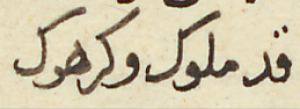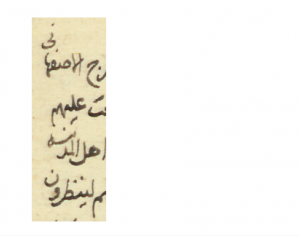About this manuscript
This lesson’s manuscript, Or. 817 of Ibn Nubātah’s Sarḥ al-ʿuyūn was written in 969/1562 in Ottoman Turkey, and presents a standard naskh bookhand which is not calligraphically-remarkable, though it is regular and efficient and quite typical of the massive manuscript production during the Ottoman era.
Naskh bookhand differs from modern printed Arabic most obviously in the less consistent approach copyists took to pointing letters and writing hamzas. See lesson 2 for details on these differences. The other major differences between manuscript naskh and modern printed Arabic concern the shapes of some letters, the forms in which letters join each other, and some common copyist quirks of naskh conventions.
Letter Shapes
As in some printed Arabic fonts, the letter mīm in naskh can be significantly squeezed, as in the examples والحكمة, and والمغرب and القديمة illustrated below. The constricting of the medial mīm followed some conventions - it often takes the forms below specifically when it joins with a lām, kāf or one of the various letters of the bā-shape family.

The writing of بن in names was made more efficient by reducing the ‘bowl’ of the nūn, making it more resemble a rāʾ, as in the example (below right): عبد الله بن جعفر, note also how the ‘tail’ of the rāʾ in Jaʿfar ends with an upstroke, which is another common feature (and similar to the medial rāʾ in المغرب, above). Also common is the constricted form of the hāʾ at the end of معه, whereby the loop of the hāʾ is not written, and replaced with a short downward stroke.

Unlike modern printed Arabic, the kāf does not always have the shaklah point when the letter is in final position, as in the example illustrated below right: قد ملوك وكرهوك

Joining Letters (Ligatures)
Naskh writing also includes ligatures that seem to connect words or letters which in printed Arabic are more distinctly spaced. This is particularly common for letters with ‘tails’ in their final/non-joined form, such as rāʾ, wāw, mīm and fāʾ. Consider the images below: the final rāʾ letter in the two examples: الفقير إلى and وهو الأشهر أن joins (or almost joins) the beginning of the following word. Likewise, observe how the the medial wāw in محمود joins the final dāl (this is also a good example of the constricted circle of the mīm when joined with a ḥāʾ). Similarly, the final mīm contorts upwards to connect with the following word in the example ثم قال.

Stacking
Manuscripts written in naskh often contain stacked letters at the end of the line: the copyist runs out of room to complete a word and resorts to writing the run-on letters above the word to preserve the margin. See the end of line words الاصفهاني, المدينة, and لينظرون in the illustration.

Transcription
Go to f 57r in the viewer and transcribe the first nine lines of the entry on al-Sulayk ibn al-Sulaka (his name is written in red). It may be easier to open the viewer in a second tab, so that you have it in your screen next to the box below. Type one line in the manuscript as one line in the box below. Make sure that you insert no blank lines. After one line or more, click the button "compare". Three dots will appear in places where you have misread letters; you can retype the incorrect letters, and once no dots appear in the below, you have transcribed the text 100% correctly.
